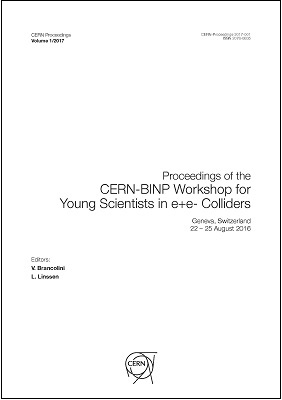Vertex and Tracker Research and Development for CLIC
DOI:
https://doi.org/10.23727/CERN-Proceedings-2017-001.165Abstract
Challenging detector requirements are imposed by the physics goals at the future multi-TeV e+e− Compact Linear Collider (CLIC). A single point resolution of 3 μm for the vertex detector and 7 μm for the tracker is required. Moreover, the CLIC vertex detector and tracker need to be extremely light weighted with a material budget of 0.2%X0 per layer in the vertex detector and 1 - 2%X0 in the tracker. A fast time slicing of 10 ns is further required to suppress background from beam-beam interactions. A wide range of sensor and readout ASIC technologies are investigated within the CLIC silicon pixel R&D effort. Various hybrid planar sensor assemblies with a pixel size of 25 × 25 μm2 and 55 × 55 μm2 have been produced and characterised by laboratory measurements and during test-beam campaigns. Experimental and simulation results for thin (50 μm- 500 μm) slim edge and active-edge planar, and High-Voltage CMOS sensors hybridised to various readout ASICs (Timepix, Timepix3, CLICpix) are presented.
Downloads
Published
Issue
Section
License
Authors who publish with this journal agree to the following terms:- Authors retain copyright and grant the journal right of first publication with the work simultaneously licensed under a Creative Commons Attribution License CC-BY-4.0 (link to external page) that allows others to share the work with an acknowledgement of the work's authorship and initial publication in this journal.
- Authors are able to enter into separate, additional contractual arrangements for the non-exclusive distribution of the journal's published version of the work (e.g., post it to an institutional repository or publish it in a book), with an acknowledgement of its initial publication in this journal.
- Authors are permitted and encouraged to post their work online (e.g., in institutional repositories or on their website) prior to and during the submission process, as it can lead to productive exchanges, as well as earlier and greater citation of published work (See The Effect of Open Access).

